BUS6004 - Quality Management in Care: Teamwork, Tools, and Motivation
VerifiedAdded on 2023/06/12
|15
|4846
|394
Essay
AI Summary
This essay provides a detailed analysis of quality management within a care setting, specifically Ramsay Health Care UK. It critically discusses the role and performance of teams using theories like Belbin's Team Role Theory and Tuckman's stages of team development, emphasizing the promotion of service user rights and responsibilities. The essay also appraises the use of Continuous Quality Improvement (CQI) tools such as the PDCA cycle and root cause analysis for managing care quality and improving outcomes. Furthermore, it examines motivation theory to understand the needs of social care organizations and teams in achieving person-centered care, ultimately concluding on the importance of these elements in ensuring optimal service delivery and patient well-being within healthcare practices. Desklib offers a range of similar essays and resources for students.
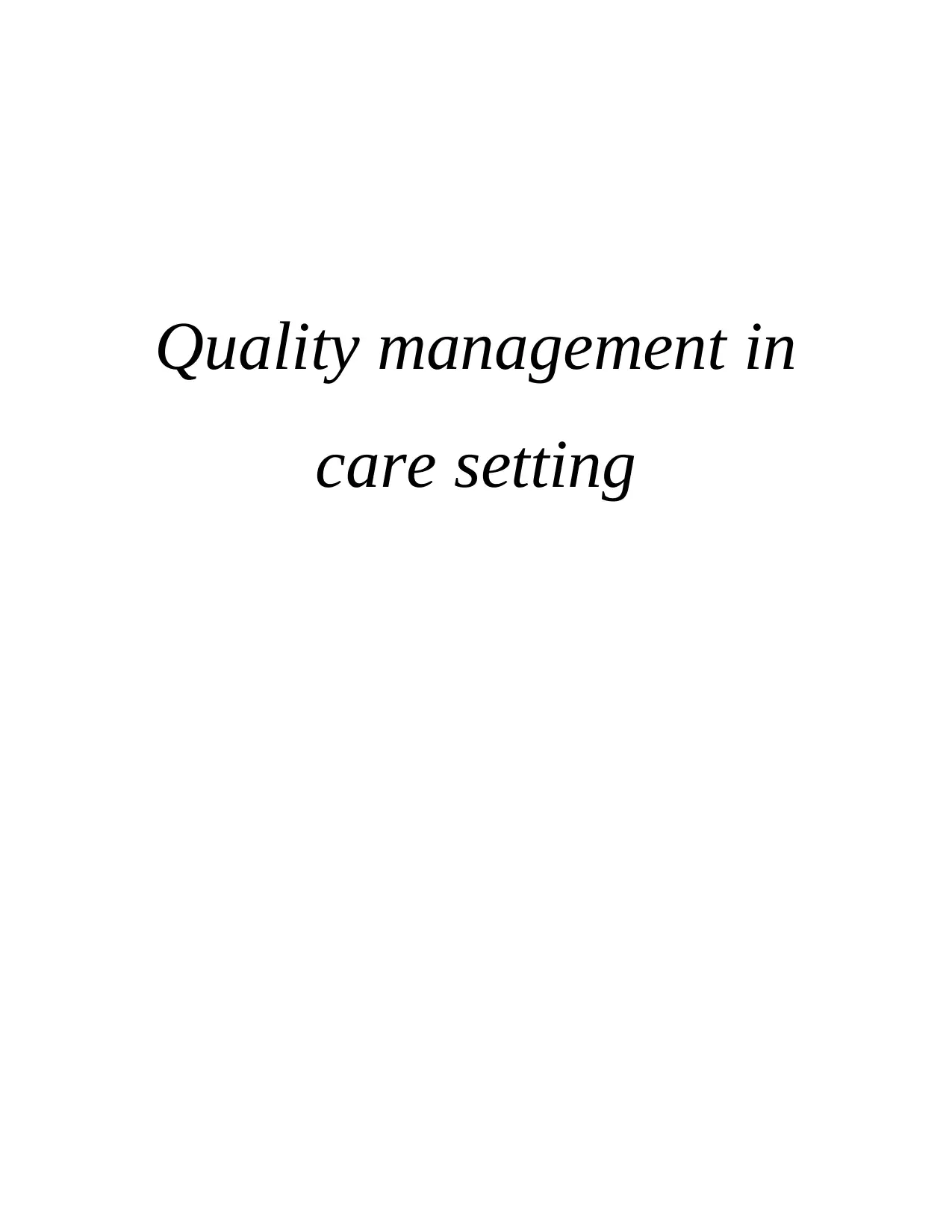
Quality management in
care setting
care setting
Paraphrase This Document
Need a fresh take? Get an instant paraphrase of this document with our AI Paraphraser
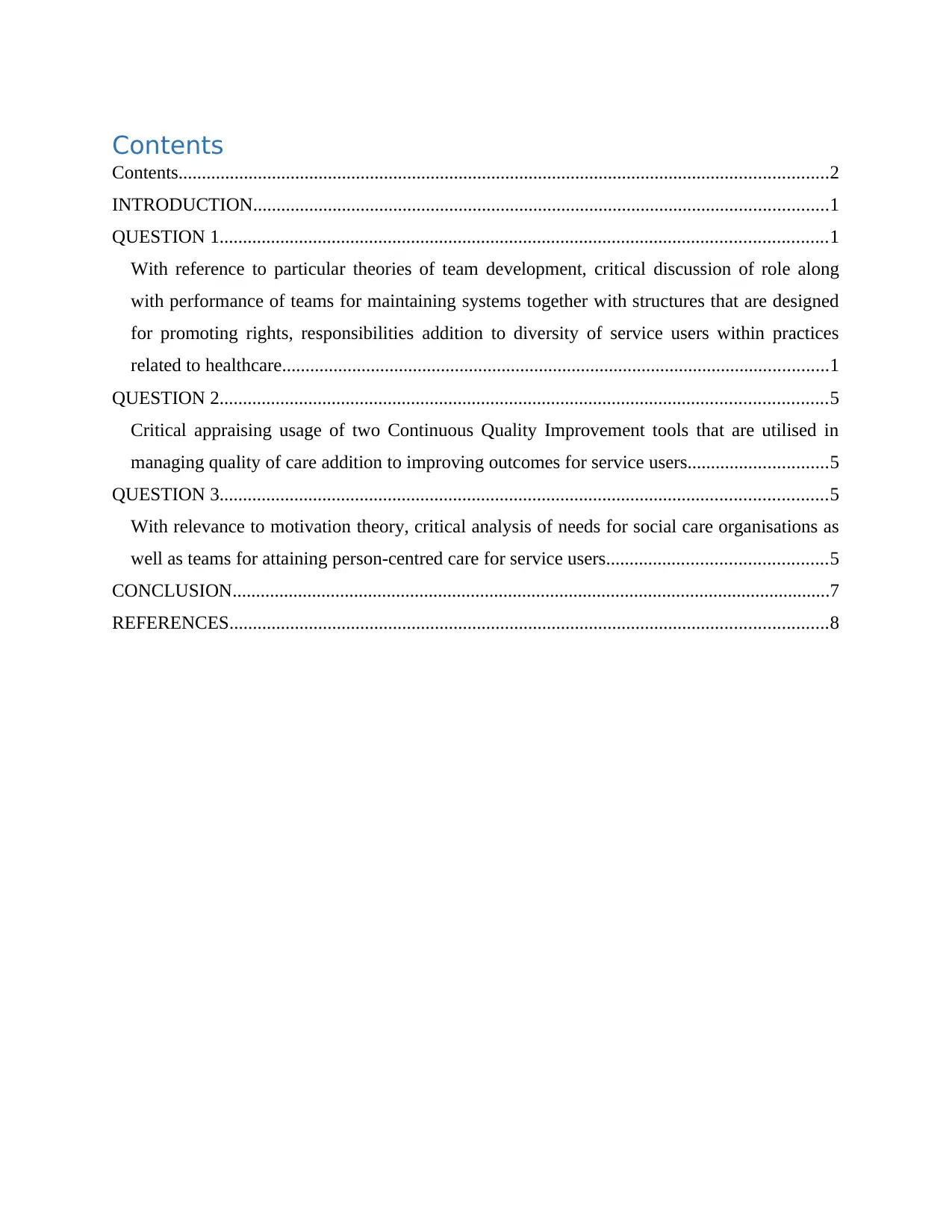
Contents
Contents...........................................................................................................................................2
INTRODUCTION...........................................................................................................................1
QUESTION 1..................................................................................................................................1
With reference to particular theories of team development, critical discussion of role along
with performance of teams for maintaining systems together with structures that are designed
for promoting rights, responsibilities addition to diversity of service users within practices
related to healthcare.....................................................................................................................1
QUESTION 2..................................................................................................................................5
Critical appraising usage of two Continuous Quality Improvement tools that are utilised in
managing quality of care addition to improving outcomes for service users..............................5
QUESTION 3..................................................................................................................................5
With relevance to motivation theory, critical analysis of needs for social care organisations as
well as teams for attaining person-centred care for service users...............................................5
CONCLUSION................................................................................................................................7
REFERENCES................................................................................................................................8
Contents...........................................................................................................................................2
INTRODUCTION...........................................................................................................................1
QUESTION 1..................................................................................................................................1
With reference to particular theories of team development, critical discussion of role along
with performance of teams for maintaining systems together with structures that are designed
for promoting rights, responsibilities addition to diversity of service users within practices
related to healthcare.....................................................................................................................1
QUESTION 2..................................................................................................................................5
Critical appraising usage of two Continuous Quality Improvement tools that are utilised in
managing quality of care addition to improving outcomes for service users..............................5
QUESTION 3..................................................................................................................................5
With relevance to motivation theory, critical analysis of needs for social care organisations as
well as teams for attaining person-centred care for service users...............................................5
CONCLUSION................................................................................................................................7
REFERENCES................................................................................................................................8

⊘ This is a preview!⊘
Do you want full access?
Subscribe today to unlock all pages.

Trusted by 1+ million students worldwide
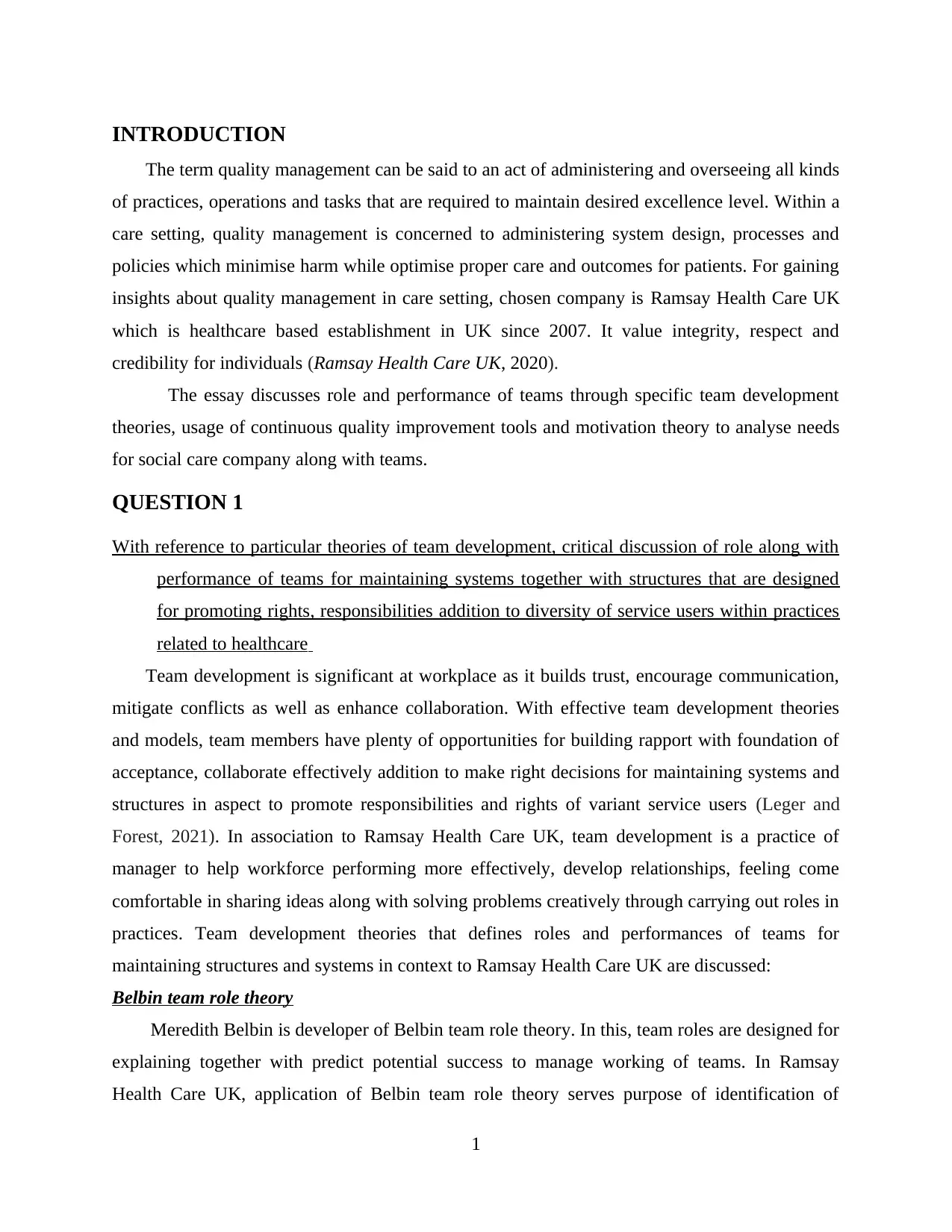
INTRODUCTION
The term quality management can be said to an act of administering and overseeing all kinds
of practices, operations and tasks that are required to maintain desired excellence level. Within a
care setting, quality management is concerned to administering system design, processes and
policies which minimise harm while optimise proper care and outcomes for patients. For gaining
insights about quality management in care setting, chosen company is Ramsay Health Care UK
which is healthcare based establishment in UK since 2007. It value integrity, respect and
credibility for individuals (Ramsay Health Care UK, 2020).
The essay discusses role and performance of teams through specific team development
theories, usage of continuous quality improvement tools and motivation theory to analyse needs
for social care company along with teams.
QUESTION 1
With reference to particular theories of team development, critical discussion of role along with
performance of teams for maintaining systems together with structures that are designed
for promoting rights, responsibilities addition to diversity of service users within practices
related to healthcare
Team development is significant at workplace as it builds trust, encourage communication,
mitigate conflicts as well as enhance collaboration. With effective team development theories
and models, team members have plenty of opportunities for building rapport with foundation of
acceptance, collaborate effectively addition to make right decisions for maintaining systems and
structures in aspect to promote responsibilities and rights of variant service users (Leger and
Forest, 2021). In association to Ramsay Health Care UK, team development is a practice of
manager to help workforce performing more effectively, develop relationships, feeling come
comfortable in sharing ideas along with solving problems creatively through carrying out roles in
practices. Team development theories that defines roles and performances of teams for
maintaining structures and systems in context to Ramsay Health Care UK are discussed:
Belbin team role theory
Meredith Belbin is developer of Belbin team role theory. In this, team roles are designed for
explaining together with predict potential success to manage working of teams. In Ramsay
Health Care UK, application of Belbin team role theory serves purpose of identification of
1
The term quality management can be said to an act of administering and overseeing all kinds
of practices, operations and tasks that are required to maintain desired excellence level. Within a
care setting, quality management is concerned to administering system design, processes and
policies which minimise harm while optimise proper care and outcomes for patients. For gaining
insights about quality management in care setting, chosen company is Ramsay Health Care UK
which is healthcare based establishment in UK since 2007. It value integrity, respect and
credibility for individuals (Ramsay Health Care UK, 2020).
The essay discusses role and performance of teams through specific team development
theories, usage of continuous quality improvement tools and motivation theory to analyse needs
for social care company along with teams.
QUESTION 1
With reference to particular theories of team development, critical discussion of role along with
performance of teams for maintaining systems together with structures that are designed
for promoting rights, responsibilities addition to diversity of service users within practices
related to healthcare
Team development is significant at workplace as it builds trust, encourage communication,
mitigate conflicts as well as enhance collaboration. With effective team development theories
and models, team members have plenty of opportunities for building rapport with foundation of
acceptance, collaborate effectively addition to make right decisions for maintaining systems and
structures in aspect to promote responsibilities and rights of variant service users (Leger and
Forest, 2021). In association to Ramsay Health Care UK, team development is a practice of
manager to help workforce performing more effectively, develop relationships, feeling come
comfortable in sharing ideas along with solving problems creatively through carrying out roles in
practices. Team development theories that defines roles and performances of teams for
maintaining structures and systems in context to Ramsay Health Care UK are discussed:
Belbin team role theory
Meredith Belbin is developer of Belbin team role theory. In this, team roles are designed for
explaining together with predict potential success to manage working of teams. In Ramsay
Health Care UK, application of Belbin team role theory serves purpose of identification of
1
Paraphrase This Document
Need a fresh take? Get an instant paraphrase of this document with our AI Paraphraser
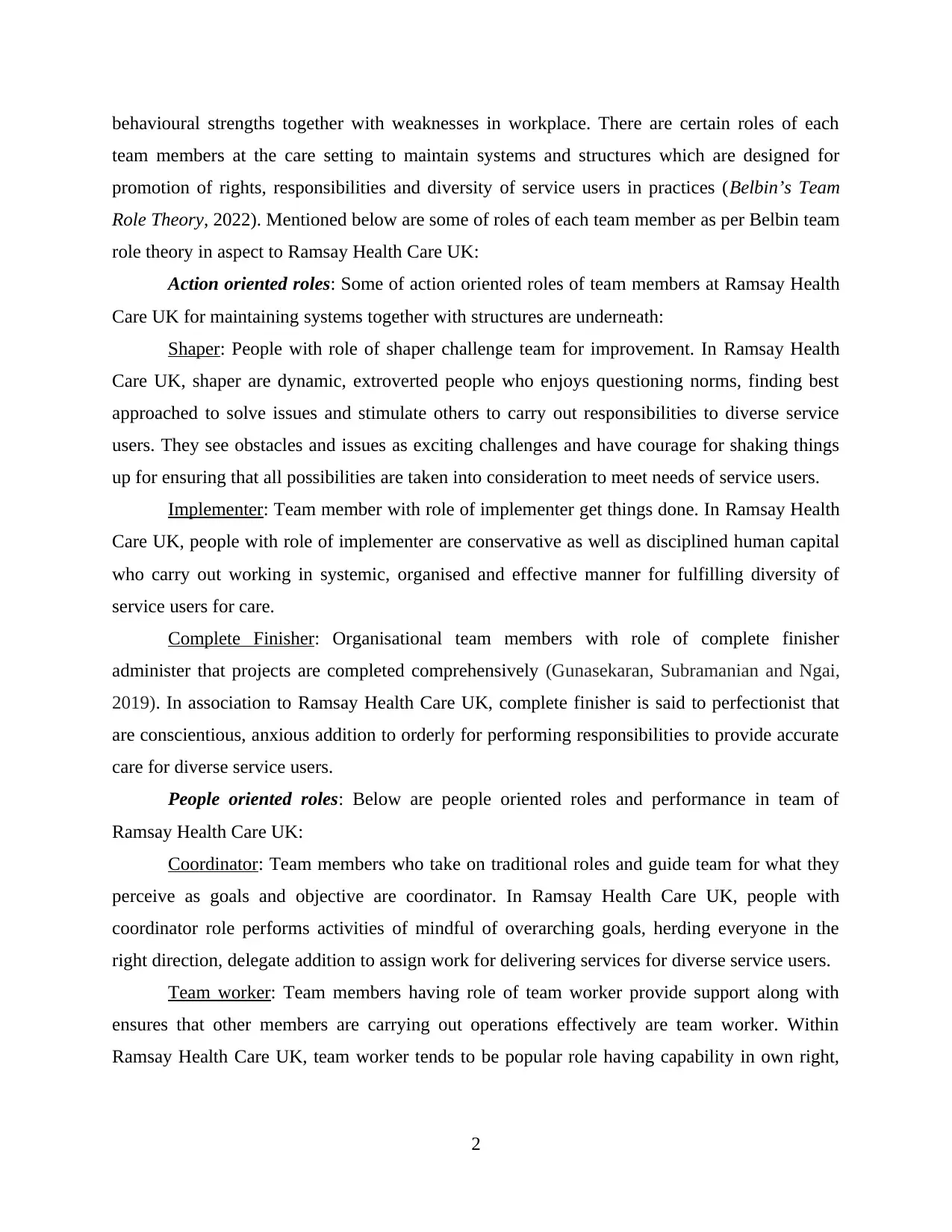
behavioural strengths together with weaknesses in workplace. There are certain roles of each
team members at the care setting to maintain systems and structures which are designed for
promotion of rights, responsibilities and diversity of service users in practices (Belbin’s Team
Role Theory, 2022). Mentioned below are some of roles of each team member as per Belbin team
role theory in aspect to Ramsay Health Care UK:
Action oriented roles: Some of action oriented roles of team members at Ramsay Health
Care UK for maintaining systems together with structures are underneath:
Shaper: People with role of shaper challenge team for improvement. In Ramsay Health
Care UK, shaper are dynamic, extroverted people who enjoys questioning norms, finding best
approached to solve issues and stimulate others to carry out responsibilities to diverse service
users. They see obstacles and issues as exciting challenges and have courage for shaking things
up for ensuring that all possibilities are taken into consideration to meet needs of service users.
Implementer: Team member with role of implementer get things done. In Ramsay Health
Care UK, people with role of implementer are conservative as well as disciplined human capital
who carry out working in systemic, organised and effective manner for fulfilling diversity of
service users for care.
Complete Finisher: Organisational team members with role of complete finisher
administer that projects are completed comprehensively (Gunasekaran, Subramanian and Ngai,
2019). In association to Ramsay Health Care UK, complete finisher is said to perfectionist that
are conscientious, anxious addition to orderly for performing responsibilities to provide accurate
care for diverse service users.
People oriented roles: Below are people oriented roles and performance in team of
Ramsay Health Care UK:
Coordinator: Team members who take on traditional roles and guide team for what they
perceive as goals and objective are coordinator. In Ramsay Health Care UK, people with
coordinator role performs activities of mindful of overarching goals, herding everyone in the
right direction, delegate addition to assign work for delivering services for diverse service users.
Team worker: Team members having role of team worker provide support along with
ensures that other members are carrying out operations effectively are team worker. Within
Ramsay Health Care UK, team worker tends to be popular role having capability in own right,
2
team members at the care setting to maintain systems and structures which are designed for
promotion of rights, responsibilities and diversity of service users in practices (Belbin’s Team
Role Theory, 2022). Mentioned below are some of roles of each team member as per Belbin team
role theory in aspect to Ramsay Health Care UK:
Action oriented roles: Some of action oriented roles of team members at Ramsay Health
Care UK for maintaining systems together with structures are underneath:
Shaper: People with role of shaper challenge team for improvement. In Ramsay Health
Care UK, shaper are dynamic, extroverted people who enjoys questioning norms, finding best
approached to solve issues and stimulate others to carry out responsibilities to diverse service
users. They see obstacles and issues as exciting challenges and have courage for shaking things
up for ensuring that all possibilities are taken into consideration to meet needs of service users.
Implementer: Team member with role of implementer get things done. In Ramsay Health
Care UK, people with role of implementer are conservative as well as disciplined human capital
who carry out working in systemic, organised and effective manner for fulfilling diversity of
service users for care.
Complete Finisher: Organisational team members with role of complete finisher
administer that projects are completed comprehensively (Gunasekaran, Subramanian and Ngai,
2019). In association to Ramsay Health Care UK, complete finisher is said to perfectionist that
are conscientious, anxious addition to orderly for performing responsibilities to provide accurate
care for diverse service users.
People oriented roles: Below are people oriented roles and performance in team of
Ramsay Health Care UK:
Coordinator: Team members who take on traditional roles and guide team for what they
perceive as goals and objective are coordinator. In Ramsay Health Care UK, people with
coordinator role performs activities of mindful of overarching goals, herding everyone in the
right direction, delegate addition to assign work for delivering services for diverse service users.
Team worker: Team members having role of team worker provide support along with
ensures that other members are carrying out operations effectively are team worker. Within
Ramsay Health Care UK, team worker tends to be popular role having capability in own right,
2
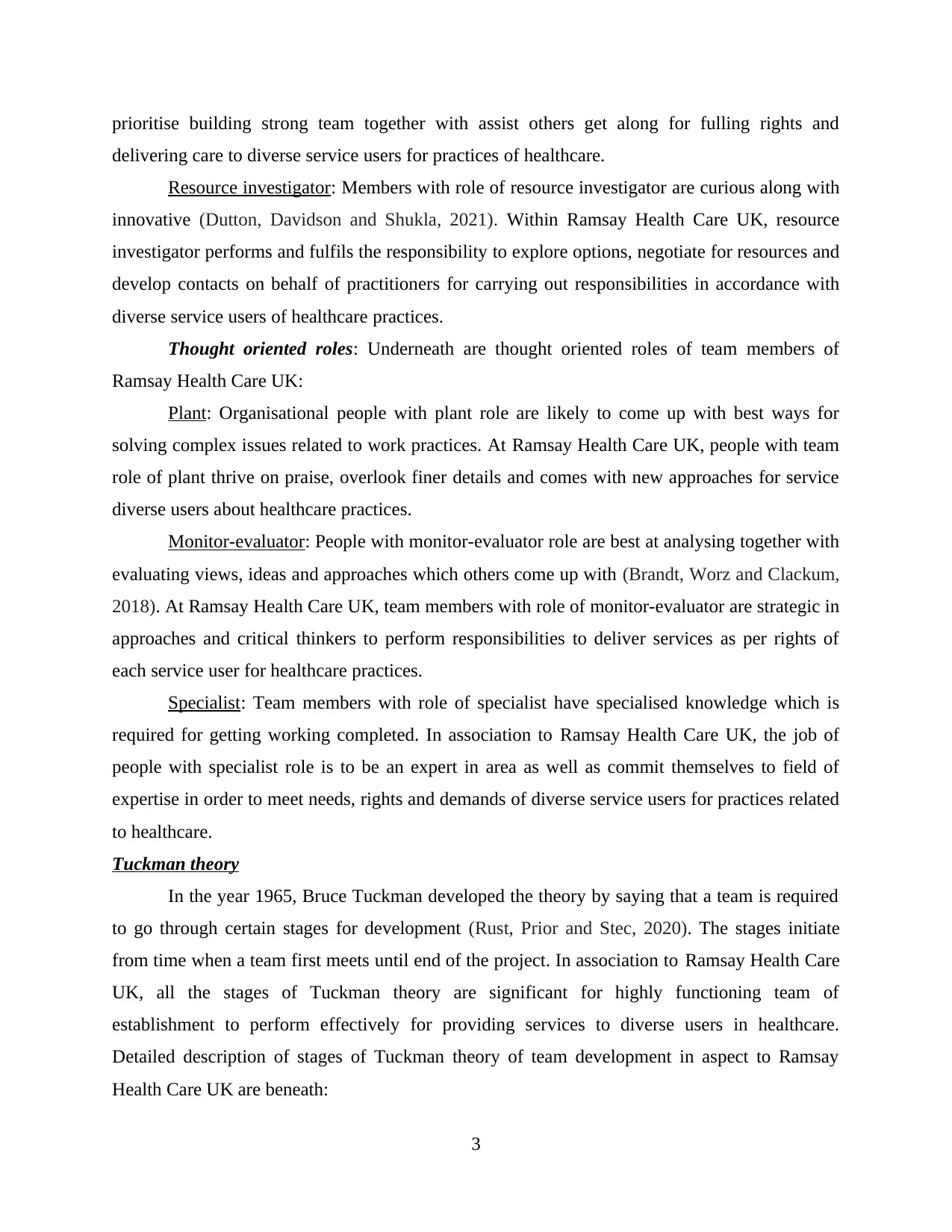
prioritise building strong team together with assist others get along for fulling rights and
delivering care to diverse service users for practices of healthcare.
Resource investigator: Members with role of resource investigator are curious along with
innovative (Dutton, Davidson and Shukla, 2021). Within Ramsay Health Care UK, resource
investigator performs and fulfils the responsibility to explore options, negotiate for resources and
develop contacts on behalf of practitioners for carrying out responsibilities in accordance with
diverse service users of healthcare practices.
Thought oriented roles: Underneath are thought oriented roles of team members of
Ramsay Health Care UK:
Plant: Organisational people with plant role are likely to come up with best ways for
solving complex issues related to work practices. At Ramsay Health Care UK, people with team
role of plant thrive on praise, overlook finer details and comes with new approaches for service
diverse users about healthcare practices.
Monitor-evaluator: People with monitor-evaluator role are best at analysing together with
evaluating views, ideas and approaches which others come up with (Brandt, Worz and Clackum,
2018). At Ramsay Health Care UK, team members with role of monitor-evaluator are strategic in
approaches and critical thinkers to perform responsibilities to deliver services as per rights of
each service user for healthcare practices.
Specialist: Team members with role of specialist have specialised knowledge which is
required for getting working completed. In association to Ramsay Health Care UK, the job of
people with specialist role is to be an expert in area as well as commit themselves to field of
expertise in order to meet needs, rights and demands of diverse service users for practices related
to healthcare.
Tuckman theory
In the year 1965, Bruce Tuckman developed the theory by saying that a team is required
to go through certain stages for development (Rust, Prior and Stec, 2020). The stages initiate
from time when a team first meets until end of the project. In association to Ramsay Health Care
UK, all the stages of Tuckman theory are significant for highly functioning team of
establishment to perform effectively for providing services to diverse users in healthcare.
Detailed description of stages of Tuckman theory of team development in aspect to Ramsay
Health Care UK are beneath:
3
delivering care to diverse service users for practices of healthcare.
Resource investigator: Members with role of resource investigator are curious along with
innovative (Dutton, Davidson and Shukla, 2021). Within Ramsay Health Care UK, resource
investigator performs and fulfils the responsibility to explore options, negotiate for resources and
develop contacts on behalf of practitioners for carrying out responsibilities in accordance with
diverse service users of healthcare practices.
Thought oriented roles: Underneath are thought oriented roles of team members of
Ramsay Health Care UK:
Plant: Organisational people with plant role are likely to come up with best ways for
solving complex issues related to work practices. At Ramsay Health Care UK, people with team
role of plant thrive on praise, overlook finer details and comes with new approaches for service
diverse users about healthcare practices.
Monitor-evaluator: People with monitor-evaluator role are best at analysing together with
evaluating views, ideas and approaches which others come up with (Brandt, Worz and Clackum,
2018). At Ramsay Health Care UK, team members with role of monitor-evaluator are strategic in
approaches and critical thinkers to perform responsibilities to deliver services as per rights of
each service user for healthcare practices.
Specialist: Team members with role of specialist have specialised knowledge which is
required for getting working completed. In association to Ramsay Health Care UK, the job of
people with specialist role is to be an expert in area as well as commit themselves to field of
expertise in order to meet needs, rights and demands of diverse service users for practices related
to healthcare.
Tuckman theory
In the year 1965, Bruce Tuckman developed the theory by saying that a team is required
to go through certain stages for development (Rust, Prior and Stec, 2020). The stages initiate
from time when a team first meets until end of the project. In association to Ramsay Health Care
UK, all the stages of Tuckman theory are significant for highly functioning team of
establishment to perform effectively for providing services to diverse users in healthcare.
Detailed description of stages of Tuckman theory of team development in aspect to Ramsay
Health Care UK are beneath:
3
⊘ This is a preview!⊘
Do you want full access?
Subscribe today to unlock all pages.

Trusted by 1+ million students worldwide
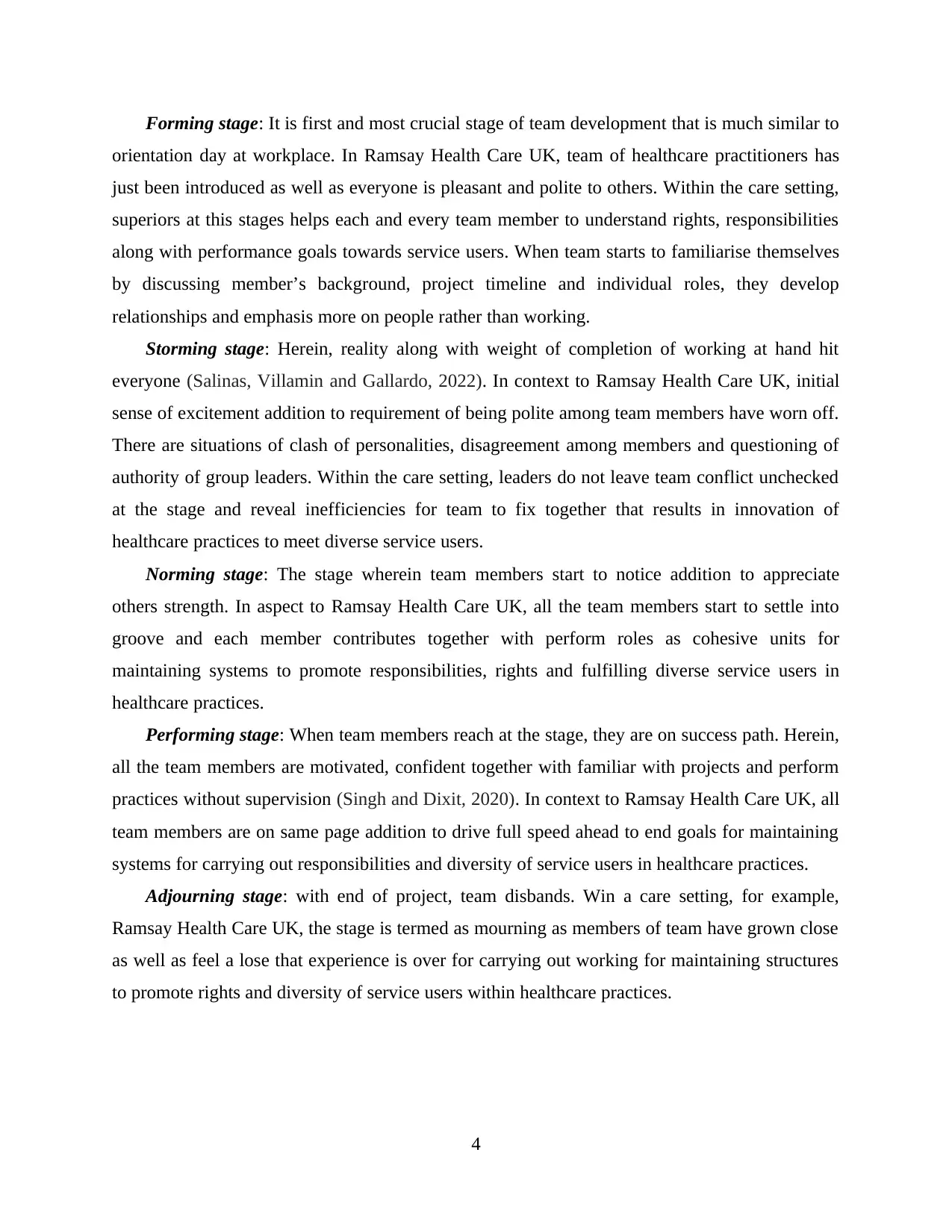
Forming stage: It is first and most crucial stage of team development that is much similar to
orientation day at workplace. In Ramsay Health Care UK, team of healthcare practitioners has
just been introduced as well as everyone is pleasant and polite to others. Within the care setting,
superiors at this stages helps each and every team member to understand rights, responsibilities
along with performance goals towards service users. When team starts to familiarise themselves
by discussing member’s background, project timeline and individual roles, they develop
relationships and emphasis more on people rather than working.
Storming stage: Herein, reality along with weight of completion of working at hand hit
everyone (Salinas, Villamin and Gallardo, 2022). In context to Ramsay Health Care UK, initial
sense of excitement addition to requirement of being polite among team members have worn off.
There are situations of clash of personalities, disagreement among members and questioning of
authority of group leaders. Within the care setting, leaders do not leave team conflict unchecked
at the stage and reveal inefficiencies for team to fix together that results in innovation of
healthcare practices to meet diverse service users.
Norming stage: The stage wherein team members start to notice addition to appreciate
others strength. In aspect to Ramsay Health Care UK, all the team members start to settle into
groove and each member contributes together with perform roles as cohesive units for
maintaining systems to promote responsibilities, rights and fulfilling diverse service users in
healthcare practices.
Performing stage: When team members reach at the stage, they are on success path. Herein,
all the team members are motivated, confident together with familiar with projects and perform
practices without supervision (Singh and Dixit, 2020). In context to Ramsay Health Care UK, all
team members are on same page addition to drive full speed ahead to end goals for maintaining
systems for carrying out responsibilities and diversity of service users in healthcare practices.
Adjourning stage: with end of project, team disbands. Win a care setting, for example,
Ramsay Health Care UK, the stage is termed as mourning as members of team have grown close
as well as feel a lose that experience is over for carrying out working for maintaining structures
to promote rights and diversity of service users within healthcare practices.
4
orientation day at workplace. In Ramsay Health Care UK, team of healthcare practitioners has
just been introduced as well as everyone is pleasant and polite to others. Within the care setting,
superiors at this stages helps each and every team member to understand rights, responsibilities
along with performance goals towards service users. When team starts to familiarise themselves
by discussing member’s background, project timeline and individual roles, they develop
relationships and emphasis more on people rather than working.
Storming stage: Herein, reality along with weight of completion of working at hand hit
everyone (Salinas, Villamin and Gallardo, 2022). In context to Ramsay Health Care UK, initial
sense of excitement addition to requirement of being polite among team members have worn off.
There are situations of clash of personalities, disagreement among members and questioning of
authority of group leaders. Within the care setting, leaders do not leave team conflict unchecked
at the stage and reveal inefficiencies for team to fix together that results in innovation of
healthcare practices to meet diverse service users.
Norming stage: The stage wherein team members start to notice addition to appreciate
others strength. In aspect to Ramsay Health Care UK, all the team members start to settle into
groove and each member contributes together with perform roles as cohesive units for
maintaining systems to promote responsibilities, rights and fulfilling diverse service users in
healthcare practices.
Performing stage: When team members reach at the stage, they are on success path. Herein,
all the team members are motivated, confident together with familiar with projects and perform
practices without supervision (Singh and Dixit, 2020). In context to Ramsay Health Care UK, all
team members are on same page addition to drive full speed ahead to end goals for maintaining
systems for carrying out responsibilities and diversity of service users in healthcare practices.
Adjourning stage: with end of project, team disbands. Win a care setting, for example,
Ramsay Health Care UK, the stage is termed as mourning as members of team have grown close
as well as feel a lose that experience is over for carrying out working for maintaining structures
to promote rights and diversity of service users within healthcare practices.
4
Paraphrase This Document
Need a fresh take? Get an instant paraphrase of this document with our AI Paraphraser
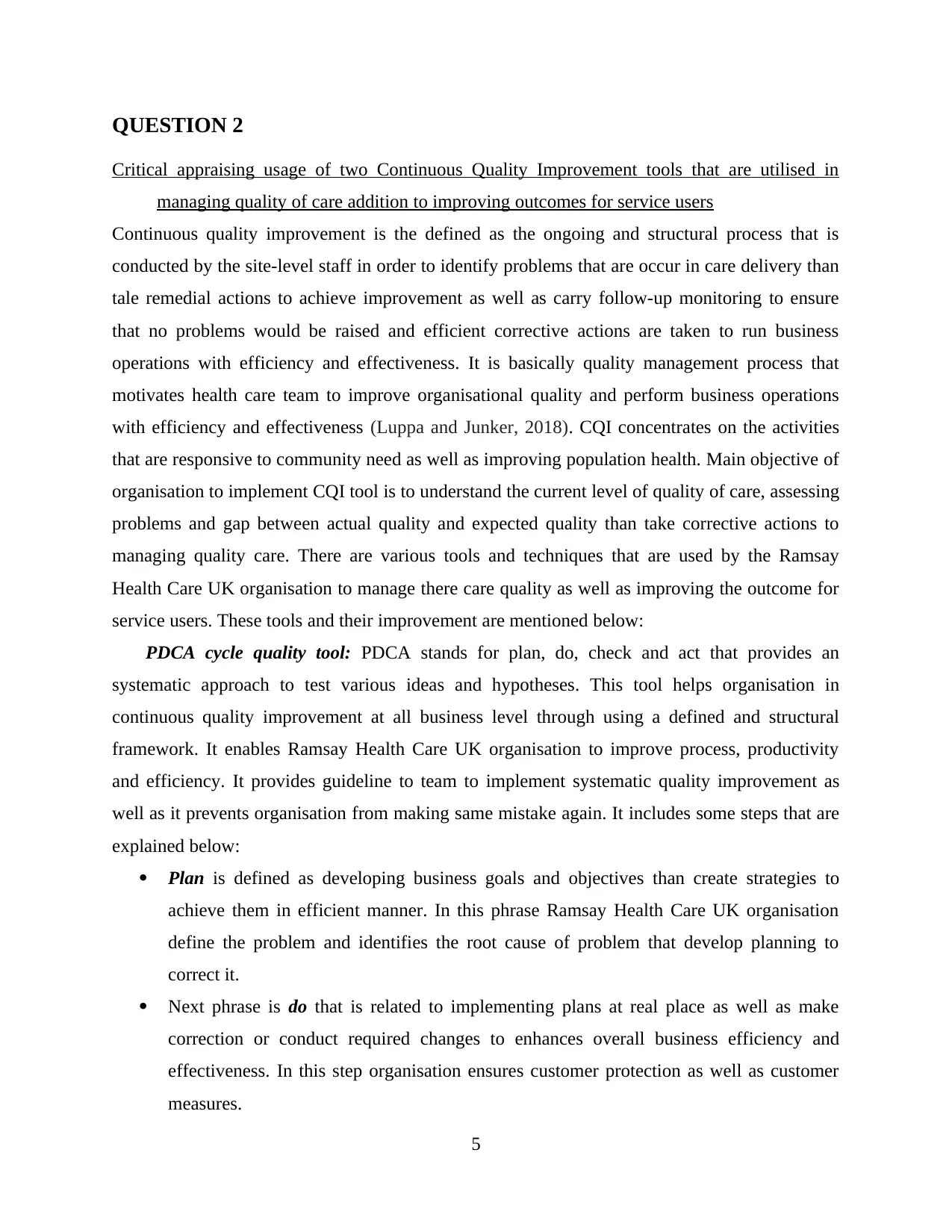
QUESTION 2
Critical appraising usage of two Continuous Quality Improvement tools that are utilised in
managing quality of care addition to improving outcomes for service users
Continuous quality improvement is the defined as the ongoing and structural process that is
conducted by the site-level staff in order to identify problems that are occur in care delivery than
tale remedial actions to achieve improvement as well as carry follow-up monitoring to ensure
that no problems would be raised and efficient corrective actions are taken to run business
operations with efficiency and effectiveness. It is basically quality management process that
motivates health care team to improve organisational quality and perform business operations
with efficiency and effectiveness (Luppa and Junker, 2018). CQI concentrates on the activities
that are responsive to community need as well as improving population health. Main objective of
organisation to implement CQI tool is to understand the current level of quality of care, assessing
problems and gap between actual quality and expected quality than take corrective actions to
managing quality care. There are various tools and techniques that are used by the Ramsay
Health Care UK organisation to manage there care quality as well as improving the outcome for
service users. These tools and their improvement are mentioned below:
PDCA cycle quality tool: PDCA stands for plan, do, check and act that provides an
systematic approach to test various ideas and hypotheses. This tool helps organisation in
continuous quality improvement at all business level through using a defined and structural
framework. It enables Ramsay Health Care UK organisation to improve process, productivity
and efficiency. It provides guideline to team to implement systematic quality improvement as
well as it prevents organisation from making same mistake again. It includes some steps that are
explained below:
Plan is defined as developing business goals and objectives than create strategies to
achieve them in efficient manner. In this phrase Ramsay Health Care UK organisation
define the problem and identifies the root cause of problem that develop planning to
correct it.
Next phrase is do that is related to implementing plans at real place as well as make
correction or conduct required changes to enhances overall business efficiency and
effectiveness. In this step organisation ensures customer protection as well as customer
measures.
5
Critical appraising usage of two Continuous Quality Improvement tools that are utilised in
managing quality of care addition to improving outcomes for service users
Continuous quality improvement is the defined as the ongoing and structural process that is
conducted by the site-level staff in order to identify problems that are occur in care delivery than
tale remedial actions to achieve improvement as well as carry follow-up monitoring to ensure
that no problems would be raised and efficient corrective actions are taken to run business
operations with efficiency and effectiveness. It is basically quality management process that
motivates health care team to improve organisational quality and perform business operations
with efficiency and effectiveness (Luppa and Junker, 2018). CQI concentrates on the activities
that are responsive to community need as well as improving population health. Main objective of
organisation to implement CQI tool is to understand the current level of quality of care, assessing
problems and gap between actual quality and expected quality than take corrective actions to
managing quality care. There are various tools and techniques that are used by the Ramsay
Health Care UK organisation to manage there care quality as well as improving the outcome for
service users. These tools and their improvement are mentioned below:
PDCA cycle quality tool: PDCA stands for plan, do, check and act that provides an
systematic approach to test various ideas and hypotheses. This tool helps organisation in
continuous quality improvement at all business level through using a defined and structural
framework. It enables Ramsay Health Care UK organisation to improve process, productivity
and efficiency. It provides guideline to team to implement systematic quality improvement as
well as it prevents organisation from making same mistake again. It includes some steps that are
explained below:
Plan is defined as developing business goals and objectives than create strategies to
achieve them in efficient manner. In this phrase Ramsay Health Care UK organisation
define the problem and identifies the root cause of problem that develop planning to
correct it.
Next phrase is do that is related to implementing plans at real place as well as make
correction or conduct required changes to enhances overall business efficiency and
effectiveness. In this step organisation ensures customer protection as well as customer
measures.
5
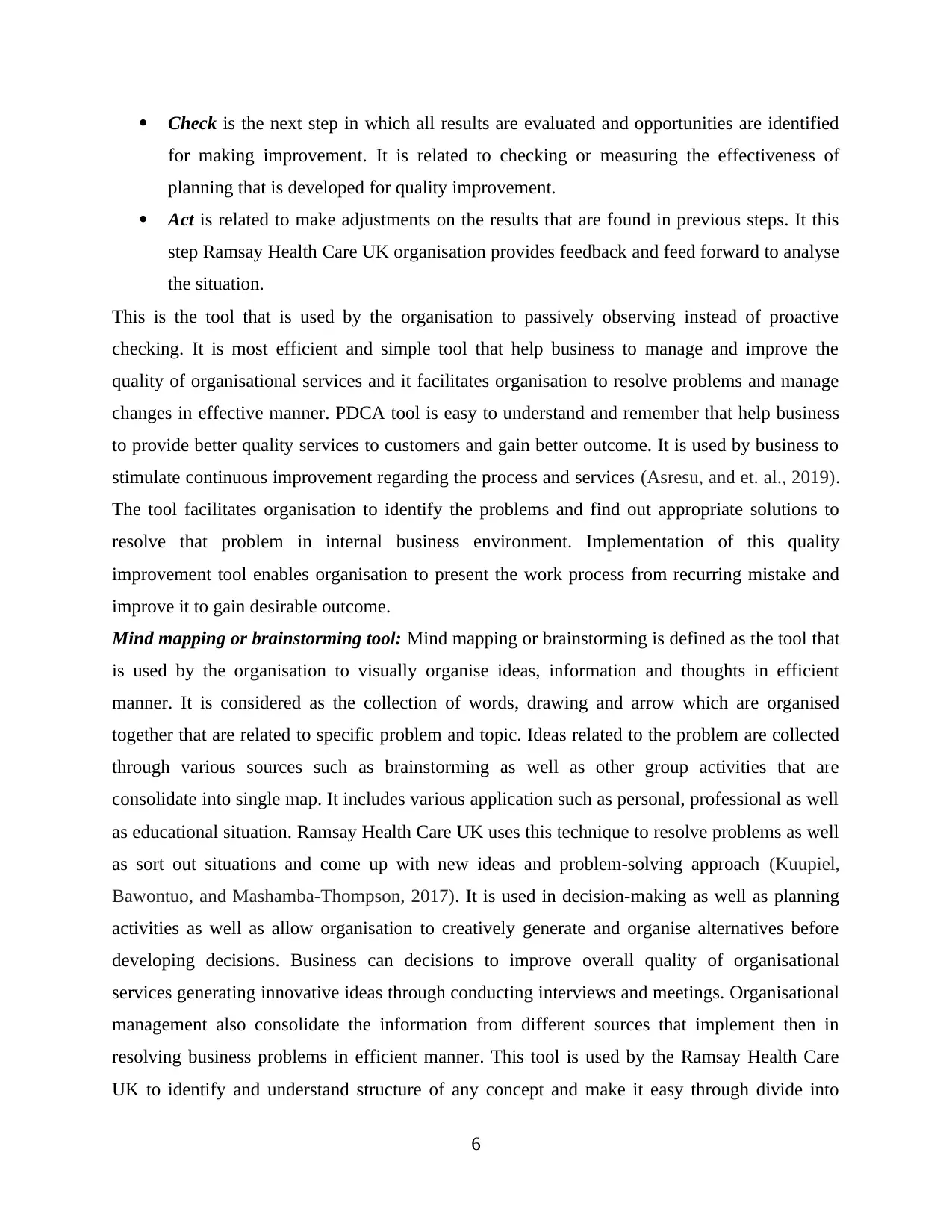
Check is the next step in which all results are evaluated and opportunities are identified
for making improvement. It is related to checking or measuring the effectiveness of
planning that is developed for quality improvement.
Act is related to make adjustments on the results that are found in previous steps. It this
step Ramsay Health Care UK organisation provides feedback and feed forward to analyse
the situation.
This is the tool that is used by the organisation to passively observing instead of proactive
checking. It is most efficient and simple tool that help business to manage and improve the
quality of organisational services and it facilitates organisation to resolve problems and manage
changes in effective manner. PDCA tool is easy to understand and remember that help business
to provide better quality services to customers and gain better outcome. It is used by business to
stimulate continuous improvement regarding the process and services (Asresu, and et. al., 2019).
The tool facilitates organisation to identify the problems and find out appropriate solutions to
resolve that problem in internal business environment. Implementation of this quality
improvement tool enables organisation to present the work process from recurring mistake and
improve it to gain desirable outcome.
Mind mapping or brainstorming tool: Mind mapping or brainstorming is defined as the tool that
is used by the organisation to visually organise ideas, information and thoughts in efficient
manner. It is considered as the collection of words, drawing and arrow which are organised
together that are related to specific problem and topic. Ideas related to the problem are collected
through various sources such as brainstorming as well as other group activities that are
consolidate into single map. It includes various application such as personal, professional as well
as educational situation. Ramsay Health Care UK uses this technique to resolve problems as well
as sort out situations and come up with new ideas and problem-solving approach (Kuupiel,
Bawontuo, and Mashamba-Thompson, 2017). It is used in decision-making as well as planning
activities as well as allow organisation to creatively generate and organise alternatives before
developing decisions. Business can decisions to improve overall quality of organisational
services generating innovative ideas through conducting interviews and meetings. Organisational
management also consolidate the information from different sources that implement then in
resolving business problems in efficient manner. This tool is used by the Ramsay Health Care
UK to identify and understand structure of any concept and make it easy through divide into
6
for making improvement. It is related to checking or measuring the effectiveness of
planning that is developed for quality improvement.
Act is related to make adjustments on the results that are found in previous steps. It this
step Ramsay Health Care UK organisation provides feedback and feed forward to analyse
the situation.
This is the tool that is used by the organisation to passively observing instead of proactive
checking. It is most efficient and simple tool that help business to manage and improve the
quality of organisational services and it facilitates organisation to resolve problems and manage
changes in effective manner. PDCA tool is easy to understand and remember that help business
to provide better quality services to customers and gain better outcome. It is used by business to
stimulate continuous improvement regarding the process and services (Asresu, and et. al., 2019).
The tool facilitates organisation to identify the problems and find out appropriate solutions to
resolve that problem in internal business environment. Implementation of this quality
improvement tool enables organisation to present the work process from recurring mistake and
improve it to gain desirable outcome.
Mind mapping or brainstorming tool: Mind mapping or brainstorming is defined as the tool that
is used by the organisation to visually organise ideas, information and thoughts in efficient
manner. It is considered as the collection of words, drawing and arrow which are organised
together that are related to specific problem and topic. Ideas related to the problem are collected
through various sources such as brainstorming as well as other group activities that are
consolidate into single map. It includes various application such as personal, professional as well
as educational situation. Ramsay Health Care UK uses this technique to resolve problems as well
as sort out situations and come up with new ideas and problem-solving approach (Kuupiel,
Bawontuo, and Mashamba-Thompson, 2017). It is used in decision-making as well as planning
activities as well as allow organisation to creatively generate and organise alternatives before
developing decisions. Business can decisions to improve overall quality of organisational
services generating innovative ideas through conducting interviews and meetings. Organisational
management also consolidate the information from different sources that implement then in
resolving business problems in efficient manner. This tool is used by the Ramsay Health Care
UK to identify and understand structure of any concept and make it easy through divide into
6
⊘ This is a preview!⊘
Do you want full access?
Subscribe today to unlock all pages.

Trusted by 1+ million students worldwide
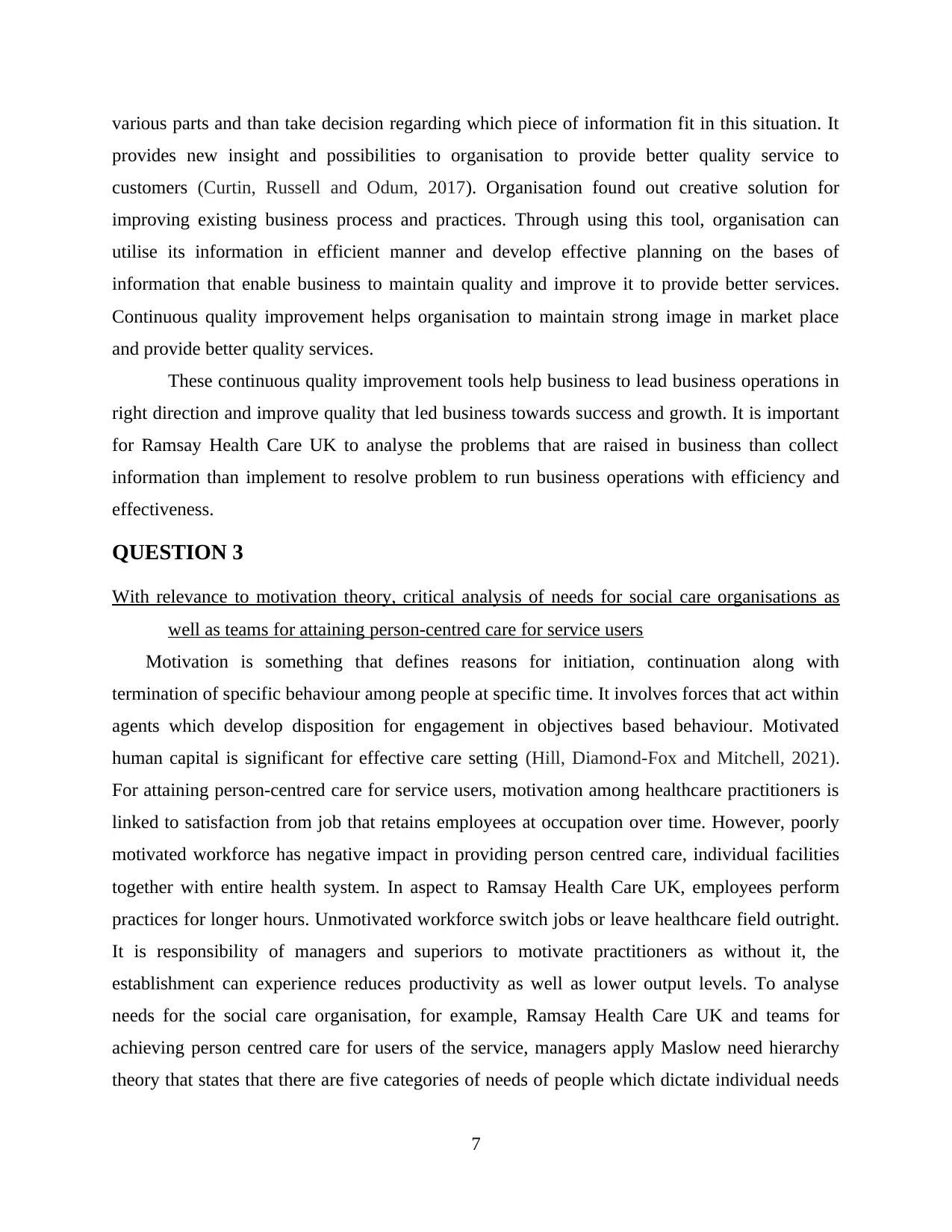
various parts and than take decision regarding which piece of information fit in this situation. It
provides new insight and possibilities to organisation to provide better quality service to
customers (Curtin, Russell and Odum, 2017). Organisation found out creative solution for
improving existing business process and practices. Through using this tool, organisation can
utilise its information in efficient manner and develop effective planning on the bases of
information that enable business to maintain quality and improve it to provide better services.
Continuous quality improvement helps organisation to maintain strong image in market place
and provide better quality services.
These continuous quality improvement tools help business to lead business operations in
right direction and improve quality that led business towards success and growth. It is important
for Ramsay Health Care UK to analyse the problems that are raised in business than collect
information than implement to resolve problem to run business operations with efficiency and
effectiveness.
QUESTION 3
With relevance to motivation theory, critical analysis of needs for social care organisations as
well as teams for attaining person-centred care for service users
Motivation is something that defines reasons for initiation, continuation along with
termination of specific behaviour among people at specific time. It involves forces that act within
agents which develop disposition for engagement in objectives based behaviour. Motivated
human capital is significant for effective care setting (Hill, Diamond-Fox and Mitchell, 2021).
For attaining person-centred care for service users, motivation among healthcare practitioners is
linked to satisfaction from job that retains employees at occupation over time. However, poorly
motivated workforce has negative impact in providing person centred care, individual facilities
together with entire health system. In aspect to Ramsay Health Care UK, employees perform
practices for longer hours. Unmotivated workforce switch jobs or leave healthcare field outright.
It is responsibility of managers and superiors to motivate practitioners as without it, the
establishment can experience reduces productivity as well as lower output levels. To analyse
needs for the social care organisation, for example, Ramsay Health Care UK and teams for
achieving person centred care for users of the service, managers apply Maslow need hierarchy
theory that states that there are five categories of needs of people which dictate individual needs
7
provides new insight and possibilities to organisation to provide better quality service to
customers (Curtin, Russell and Odum, 2017). Organisation found out creative solution for
improving existing business process and practices. Through using this tool, organisation can
utilise its information in efficient manner and develop effective planning on the bases of
information that enable business to maintain quality and improve it to provide better services.
Continuous quality improvement helps organisation to maintain strong image in market place
and provide better quality services.
These continuous quality improvement tools help business to lead business operations in
right direction and improve quality that led business towards success and growth. It is important
for Ramsay Health Care UK to analyse the problems that are raised in business than collect
information than implement to resolve problem to run business operations with efficiency and
effectiveness.
QUESTION 3
With relevance to motivation theory, critical analysis of needs for social care organisations as
well as teams for attaining person-centred care for service users
Motivation is something that defines reasons for initiation, continuation along with
termination of specific behaviour among people at specific time. It involves forces that act within
agents which develop disposition for engagement in objectives based behaviour. Motivated
human capital is significant for effective care setting (Hill, Diamond-Fox and Mitchell, 2021).
For attaining person-centred care for service users, motivation among healthcare practitioners is
linked to satisfaction from job that retains employees at occupation over time. However, poorly
motivated workforce has negative impact in providing person centred care, individual facilities
together with entire health system. In aspect to Ramsay Health Care UK, employees perform
practices for longer hours. Unmotivated workforce switch jobs or leave healthcare field outright.
It is responsibility of managers and superiors to motivate practitioners as without it, the
establishment can experience reduces productivity as well as lower output levels. To analyse
needs for the social care organisation, for example, Ramsay Health Care UK and teams for
achieving person centred care for users of the service, managers apply Maslow need hierarchy
theory that states that there are five categories of needs of people which dictate individual needs
7
Paraphrase This Document
Need a fresh take? Get an instant paraphrase of this document with our AI Paraphraser
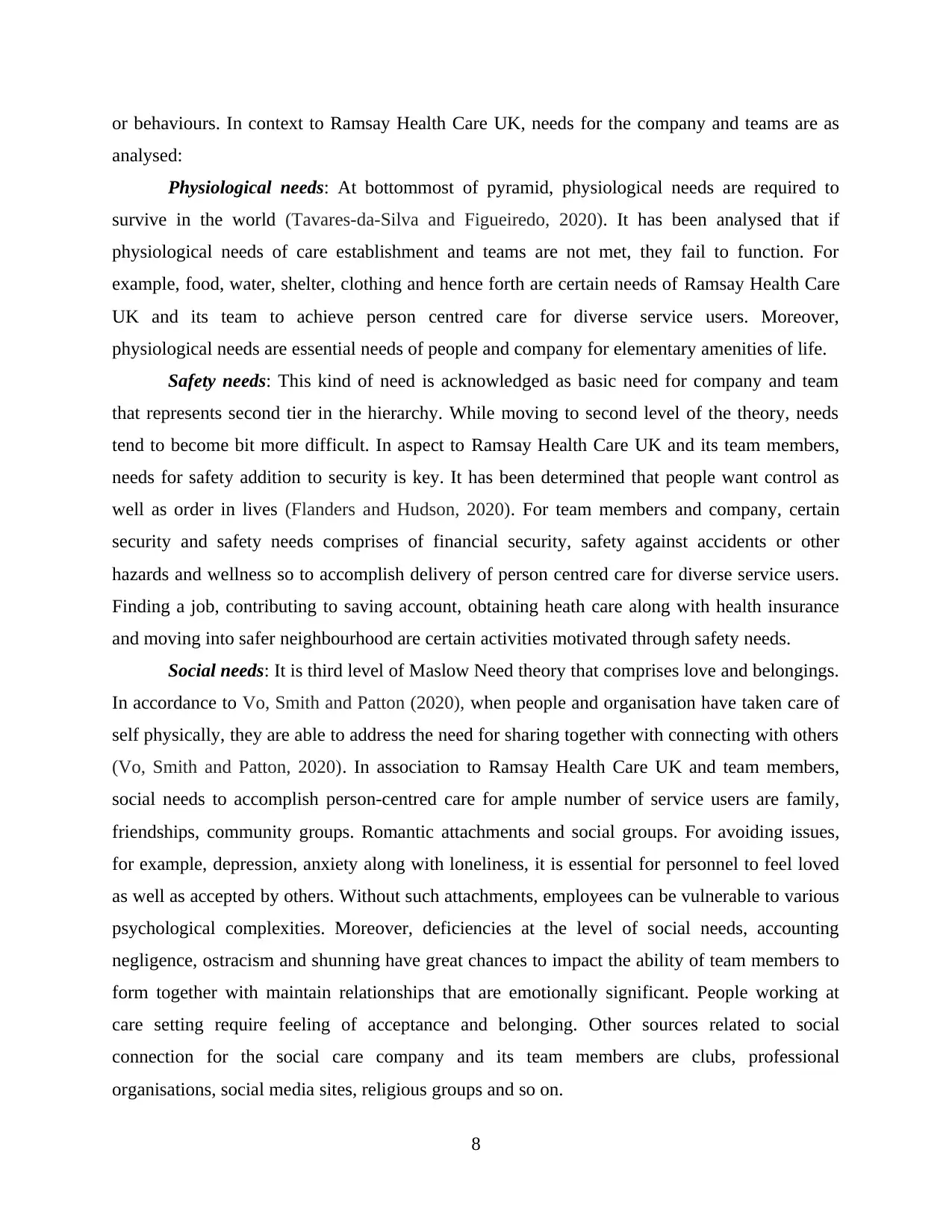
or behaviours. In context to Ramsay Health Care UK, needs for the company and teams are as
analysed:
Physiological needs: At bottommost of pyramid, physiological needs are required to
survive in the world (Tavares-da-Silva and Figueiredo, 2020). It has been analysed that if
physiological needs of care establishment and teams are not met, they fail to function. For
example, food, water, shelter, clothing and hence forth are certain needs of Ramsay Health Care
UK and its team to achieve person centred care for diverse service users. Moreover,
physiological needs are essential needs of people and company for elementary amenities of life.
Safety needs: This kind of need is acknowledged as basic need for company and team
that represents second tier in the hierarchy. While moving to second level of the theory, needs
tend to become bit more difficult. In aspect to Ramsay Health Care UK and its team members,
needs for safety addition to security is key. It has been determined that people want control as
well as order in lives (Flanders and Hudson, 2020). For team members and company, certain
security and safety needs comprises of financial security, safety against accidents or other
hazards and wellness so to accomplish delivery of person centred care for diverse service users.
Finding a job, contributing to saving account, obtaining heath care along with health insurance
and moving into safer neighbourhood are certain activities motivated through safety needs.
Social needs: It is third level of Maslow Need theory that comprises love and belongings.
In accordance to Vo, Smith and Patton (2020), when people and organisation have taken care of
self physically, they are able to address the need for sharing together with connecting with others
(Vo, Smith and Patton, 2020). In association to Ramsay Health Care UK and team members,
social needs to accomplish person-centred care for ample number of service users are family,
friendships, community groups. Romantic attachments and social groups. For avoiding issues,
for example, depression, anxiety along with loneliness, it is essential for personnel to feel loved
as well as accepted by others. Without such attachments, employees can be vulnerable to various
psychological complexities. Moreover, deficiencies at the level of social needs, accounting
negligence, ostracism and shunning have great chances to impact the ability of team members to
form together with maintain relationships that are emotionally significant. People working at
care setting require feeling of acceptance and belonging. Other sources related to social
connection for the social care company and its team members are clubs, professional
organisations, social media sites, religious groups and so on.
8
analysed:
Physiological needs: At bottommost of pyramid, physiological needs are required to
survive in the world (Tavares-da-Silva and Figueiredo, 2020). It has been analysed that if
physiological needs of care establishment and teams are not met, they fail to function. For
example, food, water, shelter, clothing and hence forth are certain needs of Ramsay Health Care
UK and its team to achieve person centred care for diverse service users. Moreover,
physiological needs are essential needs of people and company for elementary amenities of life.
Safety needs: This kind of need is acknowledged as basic need for company and team
that represents second tier in the hierarchy. While moving to second level of the theory, needs
tend to become bit more difficult. In aspect to Ramsay Health Care UK and its team members,
needs for safety addition to security is key. It has been determined that people want control as
well as order in lives (Flanders and Hudson, 2020). For team members and company, certain
security and safety needs comprises of financial security, safety against accidents or other
hazards and wellness so to accomplish delivery of person centred care for diverse service users.
Finding a job, contributing to saving account, obtaining heath care along with health insurance
and moving into safer neighbourhood are certain activities motivated through safety needs.
Social needs: It is third level of Maslow Need theory that comprises love and belongings.
In accordance to Vo, Smith and Patton (2020), when people and organisation have taken care of
self physically, they are able to address the need for sharing together with connecting with others
(Vo, Smith and Patton, 2020). In association to Ramsay Health Care UK and team members,
social needs to accomplish person-centred care for ample number of service users are family,
friendships, community groups. Romantic attachments and social groups. For avoiding issues,
for example, depression, anxiety along with loneliness, it is essential for personnel to feel loved
as well as accepted by others. Without such attachments, employees can be vulnerable to various
psychological complexities. Moreover, deficiencies at the level of social needs, accounting
negligence, ostracism and shunning have great chances to impact the ability of team members to
form together with maintain relationships that are emotionally significant. People working at
care setting require feeling of acceptance and belonging. Other sources related to social
connection for the social care company and its team members are clubs, professional
organisations, social media sites, religious groups and so on.
8
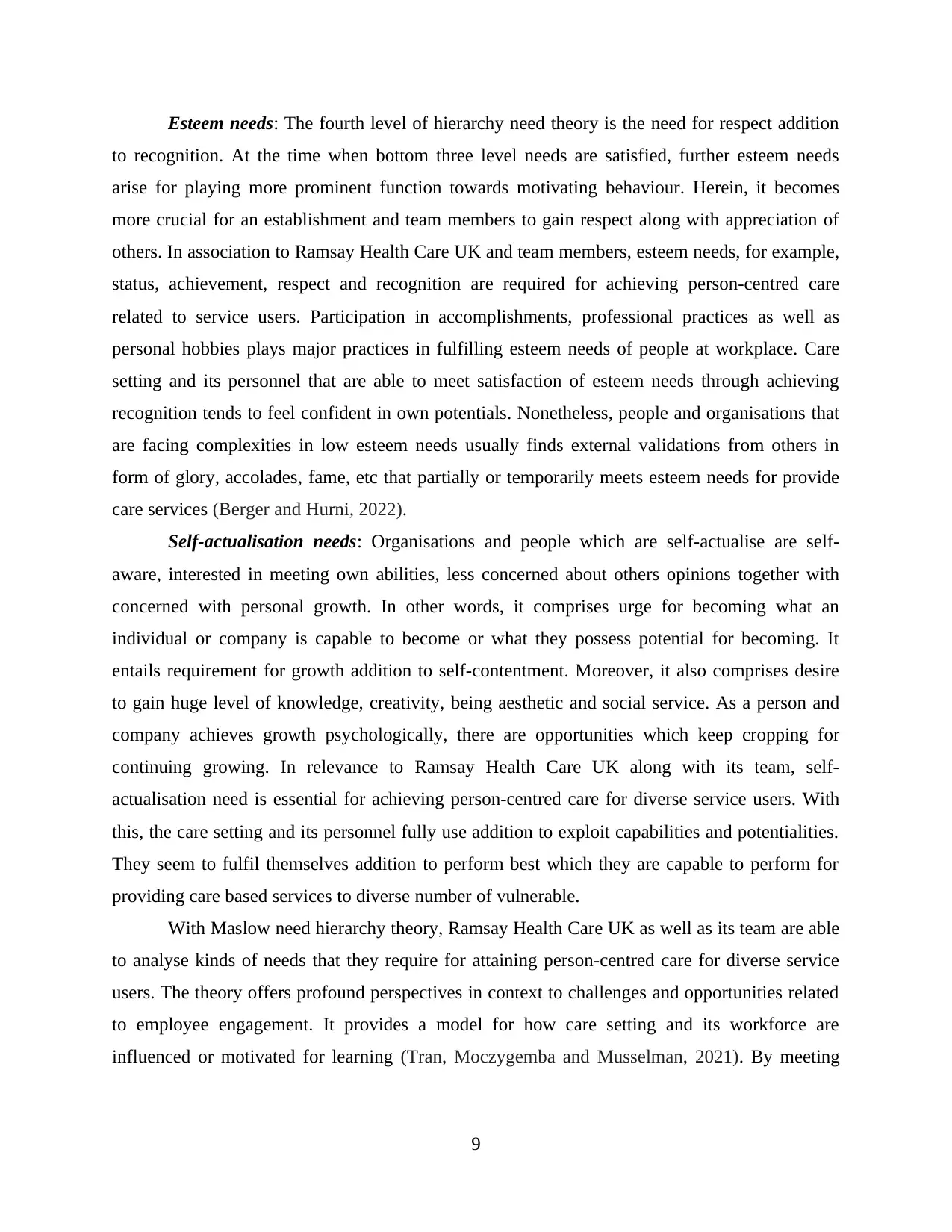
Esteem needs: The fourth level of hierarchy need theory is the need for respect addition
to recognition. At the time when bottom three level needs are satisfied, further esteem needs
arise for playing more prominent function towards motivating behaviour. Herein, it becomes
more crucial for an establishment and team members to gain respect along with appreciation of
others. In association to Ramsay Health Care UK and team members, esteem needs, for example,
status, achievement, respect and recognition are required for achieving person-centred care
related to service users. Participation in accomplishments, professional practices as well as
personal hobbies plays major practices in fulfilling esteem needs of people at workplace. Care
setting and its personnel that are able to meet satisfaction of esteem needs through achieving
recognition tends to feel confident in own potentials. Nonetheless, people and organisations that
are facing complexities in low esteem needs usually finds external validations from others in
form of glory, accolades, fame, etc that partially or temporarily meets esteem needs for provide
care services (Berger and Hurni, 2022).
Self-actualisation needs: Organisations and people which are self-actualise are self-
aware, interested in meeting own abilities, less concerned about others opinions together with
concerned with personal growth. In other words, it comprises urge for becoming what an
individual or company is capable to become or what they possess potential for becoming. It
entails requirement for growth addition to self-contentment. Moreover, it also comprises desire
to gain huge level of knowledge, creativity, being aesthetic and social service. As a person and
company achieves growth psychologically, there are opportunities which keep cropping for
continuing growing. In relevance to Ramsay Health Care UK along with its team, self-
actualisation need is essential for achieving person-centred care for diverse service users. With
this, the care setting and its personnel fully use addition to exploit capabilities and potentialities.
They seem to fulfil themselves addition to perform best which they are capable to perform for
providing care based services to diverse number of vulnerable.
With Maslow need hierarchy theory, Ramsay Health Care UK as well as its team are able
to analyse kinds of needs that they require for attaining person-centred care for diverse service
users. The theory offers profound perspectives in context to challenges and opportunities related
to employee engagement. It provides a model for how care setting and its workforce are
influenced or motivated for learning (Tran, Moczygemba and Musselman, 2021). By meeting
9
to recognition. At the time when bottom three level needs are satisfied, further esteem needs
arise for playing more prominent function towards motivating behaviour. Herein, it becomes
more crucial for an establishment and team members to gain respect along with appreciation of
others. In association to Ramsay Health Care UK and team members, esteem needs, for example,
status, achievement, respect and recognition are required for achieving person-centred care
related to service users. Participation in accomplishments, professional practices as well as
personal hobbies plays major practices in fulfilling esteem needs of people at workplace. Care
setting and its personnel that are able to meet satisfaction of esteem needs through achieving
recognition tends to feel confident in own potentials. Nonetheless, people and organisations that
are facing complexities in low esteem needs usually finds external validations from others in
form of glory, accolades, fame, etc that partially or temporarily meets esteem needs for provide
care services (Berger and Hurni, 2022).
Self-actualisation needs: Organisations and people which are self-actualise are self-
aware, interested in meeting own abilities, less concerned about others opinions together with
concerned with personal growth. In other words, it comprises urge for becoming what an
individual or company is capable to become or what they possess potential for becoming. It
entails requirement for growth addition to self-contentment. Moreover, it also comprises desire
to gain huge level of knowledge, creativity, being aesthetic and social service. As a person and
company achieves growth psychologically, there are opportunities which keep cropping for
continuing growing. In relevance to Ramsay Health Care UK along with its team, self-
actualisation need is essential for achieving person-centred care for diverse service users. With
this, the care setting and its personnel fully use addition to exploit capabilities and potentialities.
They seem to fulfil themselves addition to perform best which they are capable to perform for
providing care based services to diverse number of vulnerable.
With Maslow need hierarchy theory, Ramsay Health Care UK as well as its team are able
to analyse kinds of needs that they require for attaining person-centred care for diverse service
users. The theory offers profound perspectives in context to challenges and opportunities related
to employee engagement. It provides a model for how care setting and its workforce are
influenced or motivated for learning (Tran, Moczygemba and Musselman, 2021). By meeting
9
⊘ This is a preview!⊘
Do you want full access?
Subscribe today to unlock all pages.

Trusted by 1+ million students worldwide
1 out of 15
Related Documents
Your All-in-One AI-Powered Toolkit for Academic Success.
+13062052269
info@desklib.com
Available 24*7 on WhatsApp / Email
![[object Object]](/_next/static/media/star-bottom.7253800d.svg)
Unlock your academic potential
Copyright © 2020–2025 A2Z Services. All Rights Reserved. Developed and managed by ZUCOL.





